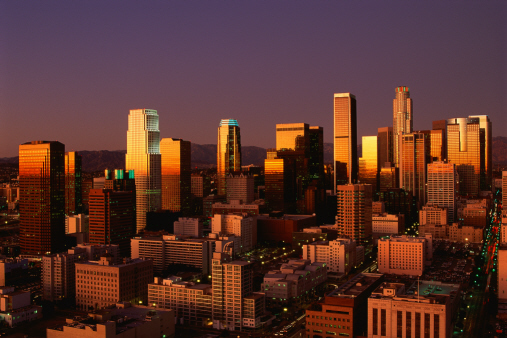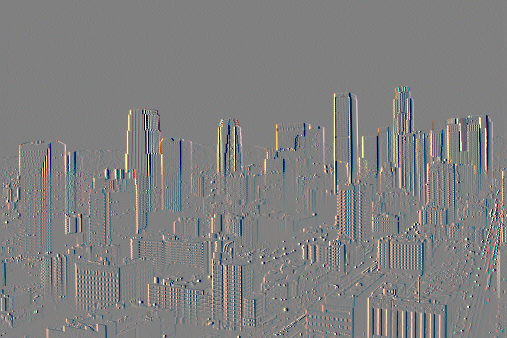L_MaskConvolutionBitmap
Summary
Applies various 3d effects to a bitmap.
Syntax
#include "l_bitmap.h"
L_LTIMGEFX_API L_INT L_MaskConvolutionBitmap(pBitmap, nAngle, uDepth, uHeight, uFlags)
Parameters
pBITMAPHANDLE pBitmap
Pointer to the bitmap handle referencing the target bitmap.
L_INT nAngle
Angle of apparent light source, in hundredths of degrees. Possible values range from -36000 to 36000.
L_UINT uDepth
The depth of the 3D effect. (This value is divided internally by 100). This value is used as a multiplier for the individual mask values.
L_UINT uHeight
Non-zero value greater than 2, that represents the height of the mask matrix. This value determines the height of the 3D effect. The larger the value, the more complex and time-consuming the operations will be.
L_UINT uFlags
Flag that indicates which mask to use in the convolution process. Possible values are:
| Value | Meaning |
|---|---|
| MSKC_EMBOSS | [0x0000] Apply the Emboss Mask on the Bitmap. |
| MSKC_EDGE | [0x0001] Apply the Edge Detection Mask on the Bitmap. |
| MSKC_ESPLOTCH | [0x0002] Apply the Emboss-Splotch Mask on the Bitmap. |
| MSKC_SPLOTCH | [0x0003] Apply the Splotch Mask on the Bitmap. |
Returns
| Value | Meaning |
|---|---|
| SUCCESS | The function was successful. |
| < 1 | An error occurred. Refer to Return Codes. |
Comments
For MSKC_EDGE, the results are the same for opposite angles. For example, angles 0 and 180 have the same result when used with the edge detection mask.
When an image undergoes image convolution each pixel of the image is multiplied by a mask to create a new pixel value. The mask is an array of values that describes the weight that should be given to each of the pixels surrounding a specific pixel. The new pixel value is the result of the mask sum being divided by the mask weight. Using different masks result in different alterations of the image. The masks used in this function result in different types of edge detection.
To obtain these bitmaps, the following settings were used:
| Parameter | Emboss | Edge | Esplotch | Splotch |
|---|---|---|---|---|
| nAngle | 0 | 0 | 180 | 0 |
| uDepth | 3 | 3 | 3 | 3 |
| uHeight | 250 | 250 | 100 | 100 |
To update a status bar or detect a user interrupt during execution of this function, refer to L_SetStatusCallback.
This function supports 12 and 16-bit grayscale and 48 and 64-bit color images. Support for 12 and 16-bit grayscale and 48 and 64-bit color images is available in the Document and Medical Imaging toolkits.
This function does not support 32-bit grayscale images. It returns the error code ERROR_GRAY32_UNSUPPORTED if a 32-bit grayscale image is passed to this function.
Mask Convolution Function - Before

Mask Convolution Function - After

View additional platform support for this Mask Convolution function.
Required DLLs and Libraries
- LTIMGEFX
- For a listing of the exact DLLs and Libraries needed, based on the toolkit version, refer to Files To Be Included With Your Application.
Platforms
Win32, x64, Linux.
See Also
Functions
- L_PlasmaFilterBitmap
- L_EmbossBitmap
- L_SharpenBitmap
- L_PosterizeBitmap
- L_MosaicBitmap
- L_AverageFilterBitmap
- L_MedianFilterBitmap
- L_AddBitmapNoise
- L_IntensityDetectBitmap
- L_SpatialFilterBitmap
- L_BinaryFilterBitmap
- L_MaxFilterBitmap
- L_MinFilterBitmap
- L_OilifyBitmap
- L_SolarizeBitmap
- L_DlgEmboss
- L_WindowLevel
- L_BumpMapBitmap
- L_CubismBitmap
- L_DrawStarBitmap
- L_DryBitmap
- L_FreePlaneBendBitmap
- L_FreeRadBendBitmap
- L_GlassEffectBitmap
- L_GlowFilterBitmap
- L_LensFlareBitmap
- L_LightBitmap
- L_OceanBitmap
- L_PlaneBendBitmap
- L_PlaneBitmap
- L_SampleTargetBitmap
- L_TunnelBitmap
- L_BendingBitmap
- L_CylindricalBitmap
- L_FreeHandShearBitmap
- L_FreeHandWaveBitmap
- L_ImpressionistBitmap
- L_PixelateBitmap
- L_PolarBitmap
- L_PunchBitmap
- L_RadialBlurBitmap
- L_RadWaveBitmap
- L_RippleBitmap
- L_SpherizeBitmap
- L_SwirlBitmap
- L_WaveBitmap
- L_WindBitmap
- L_ZoomBlurBitmap
- L_ZoomWaveBitmap
- L_AddShadowBitmap
- L_RevEffectBitmap
- L_AgingBitmap
- L_DiceEffectBitmap
- L_FunctionalLightBitmap
- L_PuzzleEffectBitmap
- L_RingEffectBitmap
- L_TextureAlphaBlendBitmap
Topics
- Raster Image Functions: Filtering Images
- Applying Artistic Effects
- Detecting and Enhancing Edges and Lines
- Raster Image Functions: Detecting and Enhancing Edges and Lines
Example
The following example applies the emboss mask over the bitmap:
L_INT MaskConvolutionBitmapExample(L_VOID){L_INT nRet;BITMAPHANDLE LeadBitmap;nRet = L_LoadBitmap(MAKE_IMAGE_PATH(TEXT("NaturalFruits.jpg")), &LeadBitmap, sizeof(BITMAPHANDLE), 0, ORDER_BGR, NULL, NULL);if (nRet != SUCCESS)return nRet;nRet = L_MaskConvolutionBitmap(&LeadBitmap, 500, 45, 3, MSKC_EMBOSS);if (nRet != SUCCESS)return nRet;nRet = L_SaveBitmap(MAKE_IMAGE_PATH(TEXT("Result.BMP")), &LeadBitmap, FILE_BMP, 24, 0, NULL);if (nRet != SUCCESS)return nRet;//free bitmapif (LeadBitmap.Flags.Allocated)L_FreeBitmap(&LeadBitmap);return SUCCESS;}
© 1991-2023 LEAD Technologies, Inc. All Rights Reserved.
